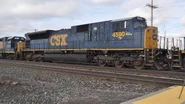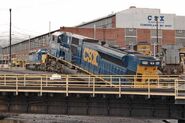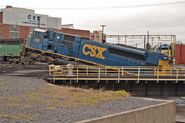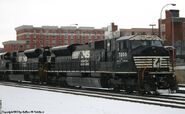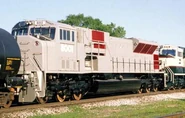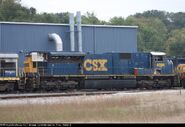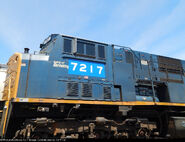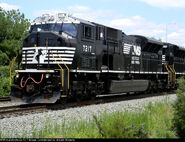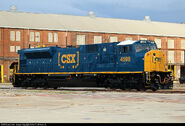Bio[]
The EMD (Electro Motive Division) SD80MAC is a type of 20-cylinder, six-axle, 5,000hp AC-traction diesel locomotive built from 1995 to 1996.
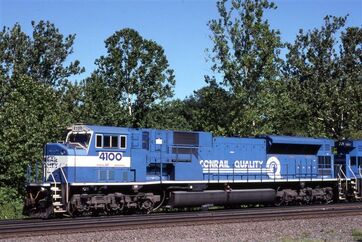
A typical SD80MAC from its respective owner.
Only 30 were built specially for Conrail, and still exist today on Norfolk Southern (NS) and are used as spare units or helpers. They were once used by CSX, yet as a result of a recent trade agreement between the two railroads in exchange for ex-CR SD40-2's. As of early 2014, CSX has since scrapped one SD80MAC: #2594 (as a result of having a cracked frame from being involved in a wreck), with only 29 remaining. They are now owned and operated by NS.
They are considered to be somewhat rare, since they're only used on certain trains or as spare units, and can only be seen in certain areas on Norfolk Southern's railroad system (though, at times, one can be spotted elsewhere from the East Coast or the Midwest).
From 2011 to 2012, Vale Mining of Brazil acquired 7 mechanically-similar Tier 1-compliant, 20-710G3C-ES-equipped SD80ACe units, and are built for use on broad-gauge 5 ft 3 in (1,600 mm) trackage. Said units are currently available for export only, for they violate current EPA emission restrictions regarding new locomotives built beginning in 2014-2015.
History[]
The SD80MAC was unique amongst North American diesel-electric locomotives to have the 20-cylinder prime-mover EMD#20v710G3B, its own unique design (apart from its externally-similar counter-part introduced prior to the model), have microprocessor controlled DC~AC invertors providing power to AC traction motors; updated HTCR-II SelfSteering Radial BogieTrucks, and to be the very first ever (and one of the only) AC-traction diesel locomotive models owned by Conrail. After the initial success of the SD70MAC in 1993 (one of the very first commercially successful, mass-produced models of single-engined AC-traction diesel locomotives produced for the North American locomotive market), EMD decided to avoid losing the competition entirely with GE's dominate and inreasingly-popular AC4400CW by introducing the SD90MAC and the externally-similar; yet much more successful and reliable (in terms of performance), SD80MAC. Thus, initiating the so-called "horsepower race" by beating GE with higher horsepower locomotives. Doing so, EMD opted to win over customers with sales exceeding expectations (they unfortunately fell short, however).
During the 1990's, the advent of AC-traction and the resultant increase in available adhesion and starting tractive effort touched off a new form of "horsepower race" as both builders (GE and EMD) sought to take advantage of the otherwise untapped potential of AC systems capable of handling more horsepower than existing locomotives could deliver. EMD revived the 20-cylinder engine fad and took the lead ahead of the competition in 1995 with the introduction of the 5,000hp SD80MAC, which was originally proven that 2 units alone could outnumber a trio of GE AC4400CW's because of the advantage of having a higher horsepower rating of 5,000hp as opposed to just 4,400hp. Furthermore, the builder also stated that 3 SD70MAC's were once capable of replacing 5 DC-traction SD40-2's, furthermore boosting sales with the already-popular (yet not widespread) model already owned by Burlington Northern, who began receiving the last of the 350+ SD70MAC's from an order originally placed in 1993. After the initial success of the otherwise unique and revolutionary SD80MAC's early run, Conrail eventually followed suit and acquired 14 SD70MAC units to accompany their existing SD80MAC fleet and were assembled at the railroad's Juniata Shops between March and May of 1998. The SD80MAC's were typically assigned and used on Conrail's long and heavy coal trains through their steep, winding, high mountain routes throughout the Northeastern United States (though, since the split of Conrail by CSX and NS in 1999, they have since found their way through various different locations across the East Coast and the rest of the United States). During the Conrail Split of 1999, CSX acquired 12, while NS acquired the 18 remaining units despite having less than 5 years in service from their original owner.
The EMD SD80MAC was successful, yet didn't receive many orders because it was more expensive to maintain and build as of a result of its more advanced and otherwise confusing control schemes, had a less horsepower rating than its more popular and favorable 6,000hp counter-part (aside from its rival: the AC6000CW), and was ultimately unpopular, for railroads preferred having more cost-effective 4,400hp to 6,000hp AC-traction diesel locomotive models as opposed to having only 5,000hp; aside from the AC4400CW (the AC6000CW's counter-part) being a more affordable choice in contrast to the 4,000hp SD70MAC and the more expensive and complicated 5,000hp SD80MAC.
Conrail was the only customer to officially order the SD80MAC, yet the Chicago And Northwestern (CNW) and Canadian Pacific (CP) originally intended on ordering such units of the model. CNW originally opted to order 15 units to assist their existing AC4400CW fleet and further replace their existing SD60 units on coal trains along the Powder River Basin in Wyoming. But because of the UP's acquisition of the CNW in 1995 and the demonstrations of SD90MAC's on CP being more successful, the orders were ultimately cancelled, and Conrail remained the only customer to fulfill their purchase after receiving 3 seperate orders of 30 units total.
Spotting Features[]
The SD80MAC shouldn't be confused for the externally-similar SD90MAC, for the simple fact that UP and CP are the current owners of the SD90MAC (aside from CEFX and CITX owning fleets of units leased to shortlines like the SLRG and INRD), while NS currently owns all SD80MAC units aqcuired from Conrail during the split of 1999, and a further 11 acquired from an auction made by CSX 15 years later in 2014.
It should also be noted that the dynamic brake grid located on the rear of the locomotive (on the far end of the long hood) is noticeably different in comparison to that of an SD90MAC.
Specifications[]
| Model | SD80MAC |
|---|---|
| Production Dates | 1995-1996 |
| Total Built | 30 |
| Length | 80' 2" |
| Wheel Arrangement | C-C |
| Engine | 20-710G3B-ES |
| Horsepower | 5,000 |
| Alternator | TA22/CA8 |
| Traction Motors | 1TB2830 |
| Weight x 1,000lbs. | 420,000 |
Trivia/Facts[]
The first two units built (EMDX 8000-8001) were assembled at EMD's London, Ontario facility, while the others were assembled at Conrail's Juniata, Pennsylvania shops. Like the SD45 (and subsequent models like the F45), the SD80MAC is one of the only models produced by EMD to feature or include a 20-cylinder engine. Most of the employees of Conrail originally weren't quite sure how to distinguish or even operate the SD80MAC because of it being completely different from their existing diesels. Thus, special tutorials were often given to help them avoid such issues (as seen in the video source).
Conrail's fleet of EMD SD80MAC's (aside from their fleet of SD70MAC's) were also painted in an exclusive scheme to distinguish them from other units.
The last Conrail-painted units were repainted back in 2009. Since then, Conrail-painted SD80MAC's no longer exist.
Once CSX finished repainting their fleet of SD80MAC's, they were eventually renumbered from their original "800 series" number fleet before eventually renumbering them again to the "4500" series to make room for new GEVO units on their roster.
As of 2015, it is now NS #7217, and is currently wearing the railroad's "Horsehead" or "Thoroughbred black" livery.
CSX #801, later renumbered as #4591, was the only SD80MAC repainted by CSX into the YN2 paint scheme. All other would be painted into the dark blue YN3 paint-scheme. CSX #4598 would be the only SD80MAC repainted in YN3b which featured the “boxcar logo”.
Norfolk Southern retired and sold the 29 unit SD80MAC fleet in February 2020. 6 units were sold to Canadian Pacific to be stripped of parts for its SD70ACu fleet while the remainping 23 units were sold to Progress Rail.
Originally NS intended to rebuild the SD80MAC fleet in similar manner that saw SD9043MAC’s rebuilt as SD70ACu’s. The SD80ACu would have differed by retaining the 20-710 prime mover which would have uprated the units to 5500hp. These plans were shelved following the adoption of Precision Scheduled Railroading operating plan, which resulted in downsizing the locomotive fleet and ultimately the retirement and sale of the SD80MAC’s. 6 were sold to CP as parts units and the remainder were sold to Progress Rail and scrapped in late 2021 despite CRHS's preservation efforts.
Gallery[]
Sources[]

Conrail SD80MAC Pt1 of 5
A video series (part 1 shown) documentary explaining the basics of an SD80MAC.

